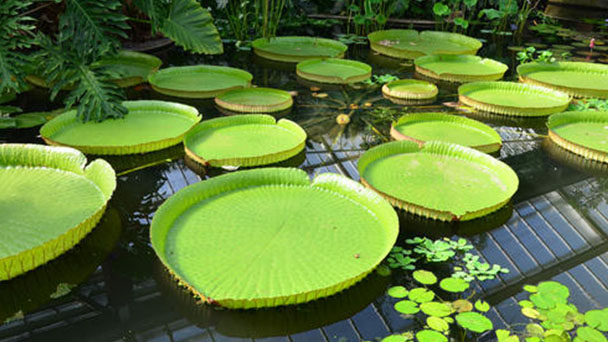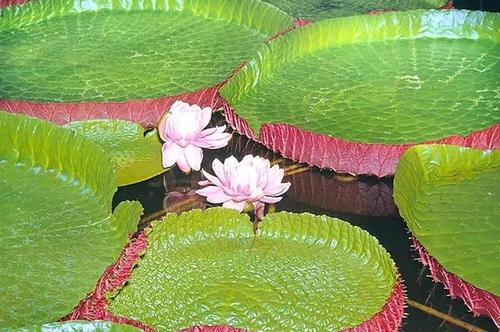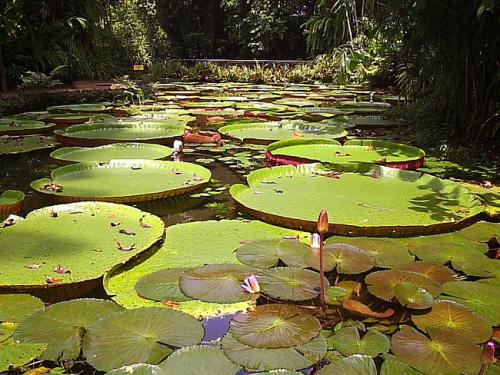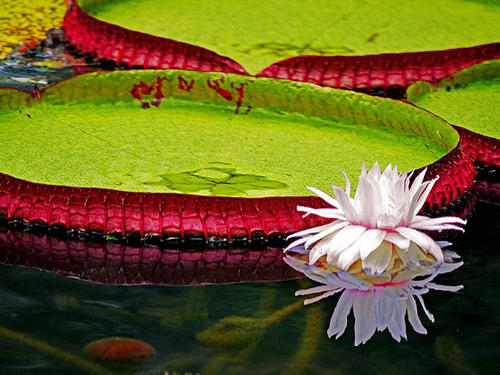Victoria amazonica profile
Written by Maggie
Dec 18 2020

Victoria Amazonica is required to grow and develop in a hot, humid, sunny environment. For example, seedlings need more than 12 hours of light. The suitable temperature for growth is 25-35℃, which is very sensitive to water temperature, and 21-24℃ is the most suitable for rapid growth. Originated in South American tropical waters, from the river bay, lakeside waters. It is mainly produced in the Amazon basin. It is the national flower of Guyana.
Victoria Amazonica is an indispensable ornamental plant in the modern garden waterscape, which can also purify water. If it is arranged in combination with lotus, water lily and other aquatic plants, it will form a perfect and unique water landscape. The seeds are about the size of lotus seeds, rich in starch and edible.
Victoria Amazonica picture

Morphological characteristics of Victoria Amazonica
Victoria Amazonica is a large perennial or annual leaf-floating herb. Rhizomes are erect lumpy, with strongly developed adventitious roots, white, soft and brittle texture. The primary leaves are needle shaped, 2-3 leaves are spear shaped, 4-5 leaves are halberd shaped, 6-10 leaves are elliptic to round, and the posterior margin of 11 leaves is upturned in disc shape, erect, 7-10 cm high.Leaf surface green slightly reddish, wrinkled, non-prickly;Abaxially purplish red, spines, veins protuberant, radiating and reticulate, veins with sharp spines 2-3 cm long; The leaves float on the water, 1-3 meters in diameter. The petiole is green, densely spiny, pedicel 1-3 m long. The leaf covers an area of about 6-10 square meters. The disc has a bearing capacity of tens of kilograms and is able to remain unfurled for a long time. These characteristics are closely related to its internal structure. A close relationship.In its blades and veins, there are many gas-filled cavities, which can greatly increase the buoyancy of the blades. On the back side of the leaf, a thick, staggered uplift veins, like a patchwork of wooden boards, forming a small square box. This structure can effectively maintain the stability of the leaf surface, so that the leaf keeps the stretch. victoria amazonica has 4 sepals, ovate-triangular, greenish-brown, outside all punctate; Victoria Amazonica petals are numerous, obovate, 10-22 cm long, white on the first day, with the aroma of white orchids, the second day petals pale red to deep red. The spectacular flowers are relatively short-lived, lasting only about 48 hours. Victoria Amazonica stamens numerous, filaments flattened, 8-10 mm long; Victoria Amazonica ovary is sub densely coarsely punctured. Berries are globose, seeds black. The Victoria Amazonica flowering period is from July to September (in the greenhouse until December).
Victoria Amazonica growing Environment
Victoria Amazonica is required to grow and develop in a hot, humid, sunny environment. For example, seedlings need more than 12 hours of light. The suitable temperature for growth is 25-35℃, which is very sensitive to water temperature. 21-24℃ is the most suitable for rapid growth, and one new leaf appears in 3-5 days. When the water temperature is slightly higher than the air temperature, it is more favorable for the growth of this species. As a typical tropical plant, Amazon royal lotus has poor cold tolerance. When the temperature drops to 20℃, its growth stagnates. When the temperature drops to about 14℃, there is cold damage, when the temperature drops to about 8℃, cold death.

Victoria Amazonica distribution range
Victoria Amazonica is originally from the tropical waters of South America. It originates from the waters of rivers and lakes. In China, in 1958, the species was first introduced to Beijing Botanical Garden of the Chinese Academy of Sciences for cultivation and flowering in a greenhouse. Later, Amazonia was cultivated in nanjing, Beijing, Shanghai, Zhengzhou, Guangzhou and other botanical gardens.
Victoria Amazonica propagation method
Victoria Amazonica propagates through seeds. After the flowers fade, the fruits fall into the water. The mature royal lotus fruit contains 300-400 seeds, with as many as 700 seeds. In the winter and spring of the same year, the Amazon royal lotus can be planted in the spring and flower in the summer. Seeds are ripened in mid-October, collected, washed and stored in water. In April, the buds were accelerated in the incubator at a low temperature and the temperature was kept at 25-28℃. The seeds were placed in the petri dish, and the depth of water was added at 2.5-3 cm. The water was changed once a day.After germination, when the bud of the second young leaf grows, the seeds can be moved into the petri dish with silt, and then grow two leaves and transplant them into the pot.
Pest control of Victoria Amazonica
The major pests of Victoria Amazonica are the twill moth and aphids. The control of Twill moth can be sprayed with 90% trichlorfon 800 times liquid. The aphids were treated with 50% aphid pine emulsion 1000 times. Fish should be prevented from gnawing during the transplanting period of Victoria Amazonicas seedlings.

Victoria Amazonica major value
Victoria Amazonica has become an indispensable ornamental plant in modern garden waterscape, which can purify water and become the king of aquatic flowers in garden waterscape. It is also a necessary precious flower in the city flower exhibition, which has high ornamental value. If it is arranged with lotus, water lily and other aquatic plants, it will form a perfect and unique water landscape. Large single plant with multiple leaf disks, solitary planting in small water has good effects. In large water bodies, many plants form a group with a magnificent momentum.
The seeds of Victoria Amazonica are about the size of lotus seeds, rich in starch and edible.
Latest Updated
- Benefits of Bugleweed - 7 Science-backed Health Benefits
- Bugleweed Dangers & Side Effects - Is It Poisonous?
- How to Plant Evergreen Trees - What You Should Know
- When to Plant Evergreens - Grow Guide for Evergreen Trees
- 12 Wonderful Evergreen Shrubs for Your Garden
- 12 Popular Evergreen Plants with Pictures for Beginners
- When And How To Prune A Lilac Bush Like a Pro
- How to Grow & Care for Lilac Vine (Hardenbergia Violacea)
- Japanese Lilac Tree (Syringa Reticulata) Care & Propagation Guide
- Shumard Oak Pros and Cons - What to Know
Popular Articles
- Winter maintenance of Antirrhinum Majus
- How to Grow Terminalia Mantaly Tree
- How to Grow and Care for Crossostephium Chinense
- How to grow Antirrhinum Majus in spring
- Peristeria Elata (Dove Orchid) Profile: Info & Care Guide
- Underwatered Snake Plant (Sansevieria Trifasciata) - Signs And How To Fix
- How to Care for Brazilian Jasmine Plant (Mandevilla Sanderi)
- How to Grow & Care for Graptopetalum Purple Delight in Summer
- Rosa Chinensis (China Rose): Plant Growing & Care Tips
- How to Care for Baby Sun Rose (Aptenia Cordifolia)